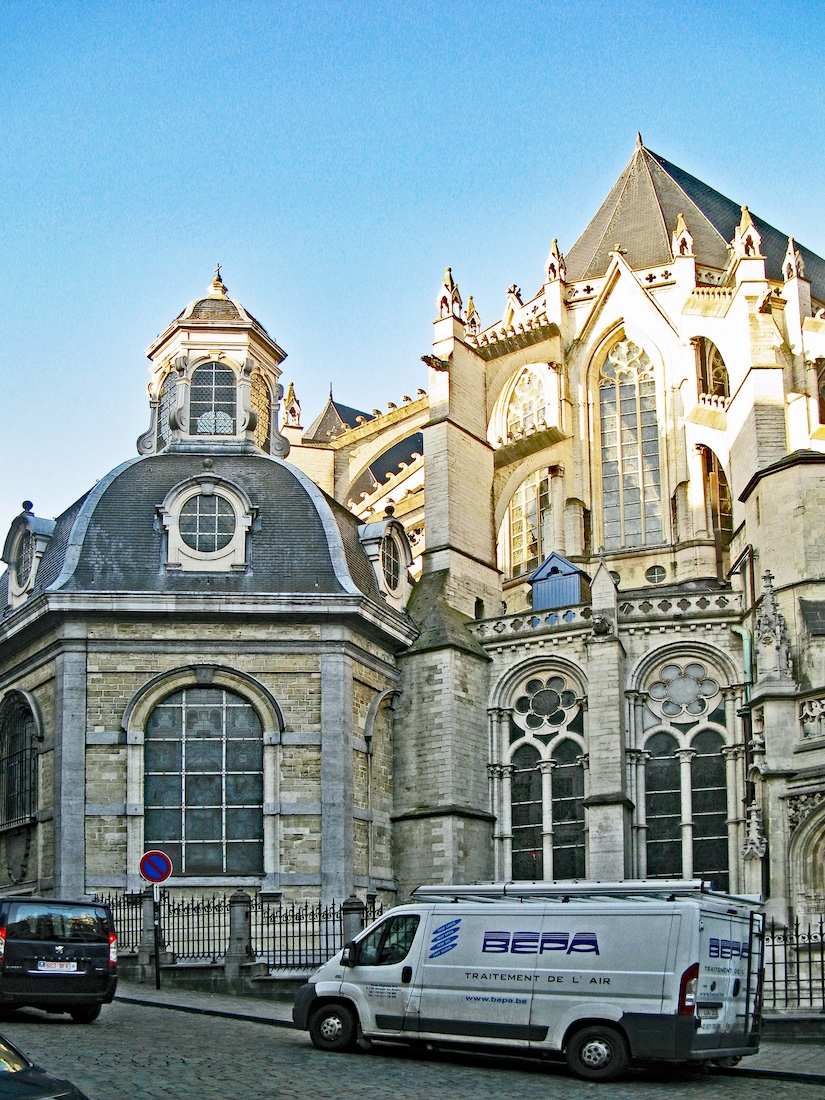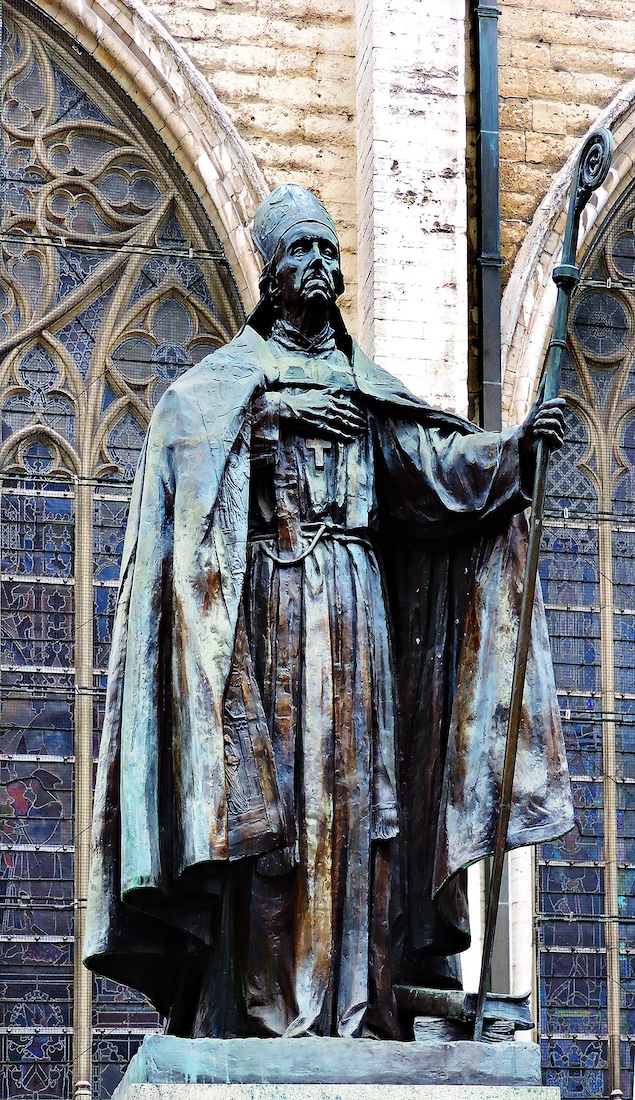

We begin our exploration of the Cathedral of St Michael and St Gudula by approaching the Cathedral through the little park to the west. We can see the graceful façade of the Cathedral through the trees, but more immediately in front of us is a staute of King Baudouin. Baudouin (7 September 1930 – 31 July 1993) was King of Belgium from 17 July 1951 until his death in 1993. [Photo1 Credit: Wikimedia Witia ; Photo2 Credit: Wikimedia EmDee] INDEX
2. WEST WALL

Moving closer we come to the grand West wall of the Cathedral. This wall is noteworthy for the beautiful precision of the details, its dramatic vertical lines, and the appearance of the end of the nave gable between the towers. It is definitely impressive! I like to notice the columns of little slit windows indicating spiral stair access up the towers. At the base of the wall is a monumental stone staircase, a gift from the City of Brussels and designed by Pieter Paul Merckx, which was placed in the period 1702–1707. We shall return to look more closely at this wall when we enter the Cathedral, but for now we walk around to the left. [Photo Credit: Wikimedia Paul Hermans]
3. ROUND TO THE NORTH NAVE
The Cathedral sits within a ring of streets, making it fairly hemmed in, and difficult to take more distant photos. Here we can see the structure of the North nave with its central gable roof, and facing out, a line of little chapels each with its small gable, and a descending downpipe! The side chapels are separated by supporting buttresses, each buttress marked by a pinnacle at the top, and another pinnacle at the bottom. We shall find that the lower windows are of beautiful stained glass, while the high clerestory windows are clear. [Photo Credit: Wikimedia Demeester]
4. NORTH TRANSEPT
We continue round to the North transept with its decorative entrance gables. From here the design of the Cathedral becomes interesting. A feature of the Brabantine Gothic design, and found frequently in French Cathedrals, is a circuit of chapels from transept to transept, accessed internally by a semicircular ambulatory around the choir and sanctuary. This occurs here, but with two special features: • there are just three such chapels here, and also, • the chapels extend out beyond the end walls of the transepts (seen at left in these views). [Photos1,2 Credit: Google Street View ]
5. NORTH WALL FIGURE
A little to the East of the North transept , we find a rather desolate figure with a missing arm. There is an information plaque below, but not legible to us.
6. ARCHANGEL MICHAEL
Further to the East a balustraded private terrace extends out beyond the side chapel. This long side chapel is officially named Miracle of the Sacrament Chapel, but we shall find it now serves as the Cathedral Museum / Treasury. We shall enjoy the many large stained glass windows when we go inside! Of interest to us here is the gilded statue looking down upon us from the terrace wall.
7. EAST END OF THE MIRACLE CHAPEL
We come to the end of the Redemption Chapel, and find that the gilded statue is in fact St Michael slaying the dragon. This is taken from the Book of Revelation, Rev 12:7–12. [Photo1 Credit1: Wikimedia Zairon; Photo2 Credit: Wikimedia Michel wal]
8. THE MAES CHAPEL
A small baroque chapel dedicated to St Mary Magdalene is situated directly East of the apse. It is also called the Maes Chapel, apparently named after the person who founded it. It is separated from the sanctuary apse by the North ambulatory, and from the outside it is interesting to view the various flying buttresses which support the main apse at this end. [Photo1 Credit: Wikimedia Demeester ; Photo2 Credit: Wikipedia EmDee]
9. TOWARDS THE SOUTH SIDE
Passing the Maes Chapel we begin our walk back along the South side of the Cathedral. We first come to the East end of the third chapel in this circuit – the large Southern ‘Our Lady of Redemption’ Chapel. Again from here we can admire the tangle of flying buttresses. We might also notice a small niche figure at the bottom, close to where the lady is passing the blue car, and nearby a curious little round turret whose purpose is a mystery! [Photo Credit: Wikimedia Zairon]
10. SOUTH ASPECT
We are now standing in the Place Sainte-Gudule, from where we can assemble a panoramic view of the South side of the Cathedral. From the right we see the windows of the Our Lady of Redemption Chapel, the South transept, the South nave windows, and the Western towers. Both towers contain bells. The South tower contains a 49-bell carillon from 1966 by the Royal Eijsbouts bell foundry, on which Sunday concerts are often given. Out of all the bells in the carillon, only seven of them can ring. They are, from heaviest to lightest: Fabiola, Maria, Michael, Gudula, Philippe, Astrid, and Laurent. Fabiola, Philippe, Astrid and Laurent are named after members of the Belgian royal family. • The North tower contains a single bourdon called Salvator, cast by Peter van den Gheyn in 1638. • The towers are also known as a nesting place for peregrine falcons. [Photo Credit: Wikimedia Uwe Brodrec ht]
11. SOUTH TRANSEPT
Looking at the South transept, we notice again how the Miracle of the Sacrament Chapel on the far side extends beyond the transept wall. Another spiral staircase is evident at the near transept corner, and on the main roof, a tall octagonal spire rises at the roof intersections of nave / choir and transepts. there are many small decorative details which could be examined on this Cathedral. [Photo Credit: Crowcanyonjournal]
12. SOUTH NAVE AND CARDINAL MERCIER
Standing by the South nave is a statue of Cardinal Mercier. Désiré Félicien François Joseph Mercier (21 November 1851 – 23 January 1926) was a Belgian cardinal of the Catholic Church and a noted scholar. A Thomist scholar, he had several of his works translated into other European languages. He was known for his book, Les origines de la psychologie contemporaine (1897). His scholarship gained him recognition from the Pope and he was appointed as Archbishop of Mechelen (Malines), serving from 1906 until his death, and was elevated to the cardinalate in 1907. Mercier is noted for his staunch resistance to the German occupation of 1914–1918 during the Great War. [Photo1 Credit: Wikimedia Uwe Brodrecht ; Photo2 Credit: Flickr Dimitris Kamaras ]
13. WEST WALL CARVINGS
We have now completed a circuit of the Cathedral, and return to the West wall. There is a strip of carved figures running across level with the top of the doors. [Photo Credit: GSV]
14. CENTRAL WEST PORTAL
I always marvel at the incredible amount of time and effort early artisans expended on creating their cathedrals. It is hard to imagine it happening today. [Photo Credit: Wikimedia Harmonia Amanda]
15. TIME TO GO INSIDE!
The West door opens and we make our way inside. [Photo Credit: Wikimedia Flocci Nivis]
16. CENTRAL NAVE
Our first view is down the central nave. This view does not do justice to the stunning beauty of this Cathedral, but there are several items of special interest here: the Twelve Apostles lining the columns, the pipe organ on the left, and the incredible Gothic pulpit at right. We shall investigate these first, after checking out the nave vaulting. [Photo Credit: Uwe Brodrecht]
17. NAVE VAULTING
This Cathedral nave has a simple rib vaulting. Each pair of opposite clerestory windows correspond to four ribs meeting together in a central boss. From the opposite vertical columns, a further pair of ribs rise to meet at the centre. The curvatures are such that a straight East-West tunnel is produced. [Photo Credit: Uwe Brodrecht]
18. TWELVE APOSTLES
We look now at the Twelve Apostles on the supporting columns. The original twelve apostles were the twelve disciples of Jesus. After Judas Iscariot betrayed Jesus, Matthias was chosen to replace him. Later, Paul called himself an apostle, although he was not one of the original apostles. In the grouping shown here, Paul appears but not Matthias. These statues date from the 17th century and were created by Lucas Faydherbe, Jerôme Duquesnoy the Younger, Johannes van Mildert and Tobias de Lelis, all renowned sculptors of their time. You can view the individual apostles here. [Photo Credit: Wikimedia Promeneuse7]
19. PIPE ORGAN
The Grenzing great organ of the Cathedral is an impressive instrument, both in its quality and its beauty. Its “bird’s nest” position meets the specific needs of the acoustics of a gothic Cathedral. This position is also linked to an old but little known tradition among organ-builders in this part of the world. You will see organs installed in similar places in other famous Gothic Cathedrals such as Chartres, Cologne or Strasbourg. The instrument has a total of 4,300 pipes, 63 stops, 4 keyboards and the pedal-board. This very beautiful instrument has been created by the daring genius of the German organ-builder, Gerhard Grenzing, based in Barcelona, in collaboration with the English architect, Simon Platt. The placing of the organ means that access is not easy: the poor organist has to follow a route of steps and passages that lead out onto the roof of the Cathedral! [Photo Credit: Wikimedia cmcmcm1]
20. PULPIT
On the opposite side from the organ is the pulpit. Dating from 1699, this is a masterpiece by Henri-Francois Verbruggen (1655-1724), a sculptor from Antwerp. It depicts Adam and Eve being chased out of the Garden of Eden and, on the top, the promise of Redemption illustrated by the Virgin Mary of the Immaculate Conception on her crescent moon stamping on the head of the serpent. This piece of furniture is so audaciously decorated that it is an unfailing source of surprise; it was brought here from the church in the Jesuit convent of Saint-Michel in Leuven. [Photo1 Credit: Wikimedia SoleilMer ; Photo2 Credit: Wilimedia Andrzej Otrebski ]
























